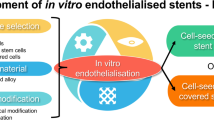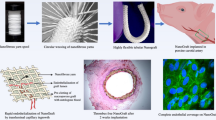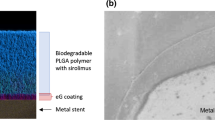Abstract
Growing clinical needs for less invasive endovascular treatments necessitate the development of advanced biomaterials that exhibit low-profile and enhanced biocompatible properties. One of the endovascular devices is a stent graft, which contains a metallic backbone, covered with thin polymeric membranes such as Dacron® and expandable polytetrafluoroethylene (ePTFE). This device has been widely used for treating various vascular diseases and injuries. While the commercial materials including Dacron® and ePTFE have demonstrated a good feasibility, they were found to induce inflammatory vessel wall reactions with neointimal hyperplasia. Consequently, it causes re-narrowing of the lumen space and thrombogenic issues that ultimately lead the treatment failure. In this paper, we introduced a thin film nitinol (TFN) as an alternative graft material and evaluated the growth behavior of endothelial cells (EC) both qualitatively and quantitatively. As a proof-of-concept study, both untreated nonpatterned film (TFN) and surface treated TFN (S-TFN) materials were used. We compared the adhesion, growth, and proliferation of ECs on a solid (non-patterned) TFN with the two most widely-used commercial graft materials (Dacron® and ePTFE). The in vitro experimental results showed better adhesion and growth of ECs on TFN materials than either ePTFE or Dacron®. Specifically, S-TFN showed approximately twice number of ECs attached on the surface than any other materials tested in this study. In addition, in vivo swine study demonstrated that ECs had a relatively high proliferation on the micropatterrned S-TFN with ~50% surface coverage within two weeks. Both in vitro and in vivo study results of cell growth suggested that TFN materials could be a promising graft material for low-profile endovascular devices.
Similar content being viewed by others
References
Humbert, I.A. & Joel, S. Tactile, gustatory, and visual biofeedback stimuli modulate neural substrates of deglutition. Neuroimage 59, 1485–1490 (2012).
Mozaffarian, D. et al. Heart Disease and Stroke Statistics-2016 Update A Report From the American Heart Association. Circulation, CIR. 0000000000000350 (2015).
Control CfD, Prevention. Underlying cause of death 1999-2010. CDC WONDER Online Database (2010).
Selvin, E. & Erlinger, T.P. Prevalence of and risk factors for peripheral arterial disease in the United States results from the national health and nutrition examination survey, 1999-2000. Circulation 110, 738–743 (2004).
Sakalihasan, N., Limet, R. & Defawe, O. Abdominal aortic aneurysm. The Lancet 365, 1577–1589 (2005).
Rinkel, G.J., Djibuti, M., Algra, A. & Van Gijn, J. Prevalence and risk of rupture of intracranial aneurysms a systematic review. Stroke 29, 251–256 (1998).
Bengtsson, H. & Bergqvist, D. Ruptured abdominal aortic aneurysm: a population-based study. J. Vasc. Surg. 18, 74–80 (1993).
Johnston, S.C., Selvin, S. & Gress, D.R. The burden, trends, and demographics of mortality from subarachnoid hemorrhage. Neurology 50, 1413–1418 (1998).
Coselli, J.S., Bozinovski, J. & LeMaire, S.A. Open surgical repair of 2286 thoracoabdominal aortic aneurysms. Ann. Thorac. Surg. 83, S862–S864 (2007).
Greenhalgh, R.M., E.V.A.R. Comparison of endovascular aneurysm repair with open repair in patients with abdominal aortic aneurysm (EVAR trial 1), 30-day operative mortality results: randomised controlled trial. The Lancet 364, 843–848 (2004).
Link, J. et al. Dacron-covered stent-grafts for the percutaneous treatment of carotid aneurysms: effectiveness and biocompatibility-experimental study in swine. Radiology 200, 397–401 (1996).
Bezzi, M. et al. New ePTFE/FEP-covered stent in the palliative treatment of malignant biliary obstruction. J. Vasc. Interv. Radiol. 13, 581–589 (2002).
Cejna, M. et al. Biocompatibility and performance of the Wallstent and several covered stents in a sheep iliac artery model. J. Vasc. Interv. Radiol. 12, 351–358 (2001).
Chun, Y., Levi, D., Mohanchandra, K., Fishbein, M. & Carman, G. Novel micro-patterning processes for thin film NiTi vascular devices. Smar. Mat. St. 19, 105021 (2010).
Santos, E., Orive, G., Pedraz, J.L. & Hernández, R.M. Cell-biomaterial interaction: strategies to mimic the extracellular matrix. INTECH Open Access Publisher (2011).
Chun, Y., Levi, D.S., Mohanchandra, K. & Carman, G.P. Superhydrophilic surface treatment for thin film NiTi vascular applications. Mater. Sci. Eng. C. Mater. Biol. Appl. 29, 2436–2441 (2009).
Dekker, A. et al. Adhesion of endothelial cells and adsorption of serum proteins on gas plasma-treated polytetrafluoroethylene. Biomaterials 12, 130–138 (1991).
Le Saux, G., Magenau, A., Böcking, T., Gaus, K. & Gooding, J.J. The relative importance of topography and RGD ligand density for endothelial cell adhesion. PLoS One 6, e21869 (2011).
Ho, K.K. & Carman, G.P. Sputter deposition of NiTi thin film shape memory alloy using a heated target. Thin Solid Films 370, 18–29 (2000).
Mohanchandra, K.P., Chun, Y., Prikhodko, S.V. & Carman, G.P. TEM characterization of super-hydrophilic Ni-Ti thin film. Materials Letters 65, 1184–1187 (2011).
Tulloch, A.W. et al. Super hydrophilic thin film nitinol demonstrates reduced platelet adhesion compared with commercially available endograft materials. J. Surg. Res. 171, 317–322 (2011).
Author information
Authors and Affiliations
Corresponding author
Rights and permissions
About this article
Cite this article
Chen, Y., Shayan, M., Yeo, WH. et al. Assessment of endothelial cell growth behavior in thin film nitinol. BioChip J 11, 39–45 (2017). https://doi.org/10.1007/s13206-016-1106-7
Received:
Accepted:
Published:
Issue Date:
DOI: https://doi.org/10.1007/s13206-016-1106-7




